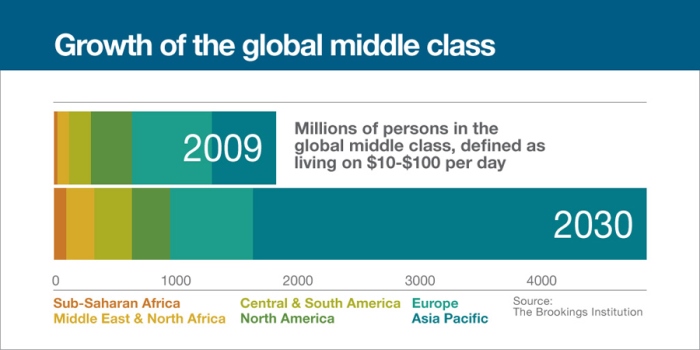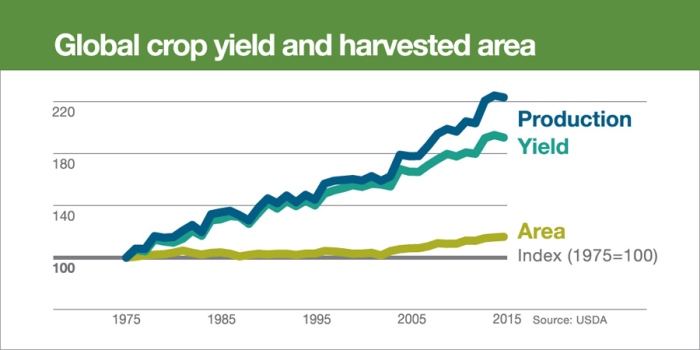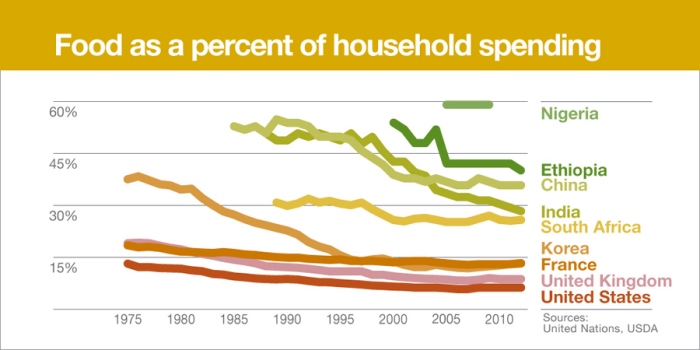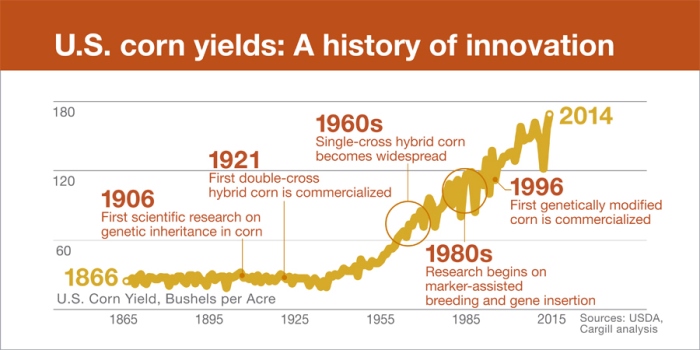In 4 Charts: The Past, Present and Future of Food Security
On World Food Day 2015, as people pause around the globe to consider how we feed ourselves, it’s worth taking a step back to look at the bigger picture. What are the challenges facing humanity as we move to a world with more than 9 billion people by 2050? How did we get to where we are today? And what do we need to do to keep making progress?
The truth is that the global food system has always been changing, and will need to keep changing to meet the needs of tomorrow.
Today, while food is vital to local cultures everywhere, we have a food system supported by a global network of actors from farm to fork. Many factors – including urbanization, infrastructure, government policy, evolving consumer preferences, rising incomes and climate change, to name a few – trigger shifts and disruptions in how food is grown, handled and distributed.
When we look at the challenges ahead of us, while it’s true that we will need to feed more than 9 billion by 2050, this simple statement glosses over a lot of complexities.
For example, nested within that projected population growth is a rapid expansion in the global middle class:

In just over two decades, billions of people are expected to move out of poverty. The number of people in the middle class will double in the Mideast and North Africa, and triple in Sub-Saharan Africa.
And in Asia, a region that already has far more people than agricultural resources to feed them, the middle class is expected to increase by more than 600 percent.
So why does this matter?
This rising standard of living is a tremendous victory, but it also will put new strains on our food system. When people’s incomes rise into this bracket, they tend to change what they eat, shifting from staple foods to more fats, oils and proteins.
So it won’t just be a matter of feeding more people, but of feeding them differently. The combination of these two factors means we will need more food. Depending on who you ask, it could be anywhere from 30 percent to 70 percent more than we grow today.
That might sound daunting, but there is reason to be optimistic.
In fact, if you look at the recent past, we’ve already achieved this feat of greatly increasing production, and we’ve done it without using much more land:

At one time in the 1960s, when the world’s population had just crossed 3 billion people, there was a common belief that this was the largest number of people the planet could support, based on the amount of food we thought we could produce at the time. Academics and policymakers feared global famine, mass starvation and a collapse in the social order.
But that didn’t happen, thanks to scientific research and innovation, including the Green Revolution that was spurred in part by Norman Borlaug’s work to develop heartier and higher-yielding strains of staple crops like wheat. Instead, we more than doubled production without significantly expanding land use.
Today, there are more than 7 billion of us on the planet. And although undernourishment remains an issue for about 11 percent of us, it’s not because we fail to produce enough calories. Poverty determines whether people get enough to eat.
But on this front, too, there is hope.

Food is becoming cheaper in most countries, including developing countries, where food has traditionally made up a higher portion of the average family’s income.
During recent decades, the downward trend of these lines indicates a massive rise in the global standard of living. In particular, China and India, which represent a significant part of the world’s population, have seen dramatically lower food costs relative to income.
If poverty is the major cause of hunger today, this chart points toward a very encouraging trend.
But as we look to the future, it’s important to remember one of the key factors that got us where we are today: scientific innovation.
Consider, for instance, what science has done for improving just one crop: corn.

For a long period in the late nineteenth and early twentieth centuries, U.S. corn yields languished at about 20-30 bushels per acre. But over time, the regular investment in scientific research paid consistent dividends to farmers and consumers.
Breakthroughs helped U.S. farmers in the fledgling Corn Belt of the 1920s and 30s achieve their first significant surpluses, and corresponding increases in incomes. Little did they know that their grandchildren would be growing six to eight times more corn than they did on the same land.
Who knows what further advances will be delivered by future research? The world record for corn yields is more than 500 bushels per acre, a mark set in 2014. We may only have scratched the surface of what’s possible, and this is just for one crop.
As we look to the future, we shouldn’t abandon scientific research and technological advances that have the potential to help us feed the world while also protecting the planet.
On Oct. 15, 2015, at the World Food Prize Borlaug Dialogue, Cargill Chairman and CEO David MacLennan delivered an expanded version of these remarks.
